-
Name of property current (historical)
-
Detroit Institute of Arts
-
Entry author
-
Yuechen Zhang
-
Abstract
-
The Detroit Institute of Arts (DIA) traces its origins back to 1883 when the Detroit Art Loan Exhibition achieved great success. Avid art collector James Scripps played a pivotal role in establishing the museum, and in 1889, he donated his impressive collection of old master artworks to the institution.
Despite its promising beginnings, the DIA encountered financial challenges after 15 years of operation. The city of Detroit took over the institution and provided funding for the construction of a new building. This grand edifice was intended to serve as the cornerstone of a cultural center in the Western United States.
Over time, the role of the DIA as a gift giver and receiver has evolved. Originally established as a private organization supported by local benefactors, the museum underwent complex role shifts for financial and legal reasons. The city and the museum justified public funding of private institutions by citing free public access as an excuse. As such, the museum became both a giver and receiver of gifts, receiving multiple public donations from the city of Detroit while also providing a valuable cultural asset to its citizens.
-
Address
-
Detroit Museum of Art: 704 E. Jefferson Ave.
Detroit Institute of Arts: 5200 Woodward Avenue, Detroit, Michigan
-
Architect
-
Detroit Museum of Art: James Balfour, who was a successful architect in Hamilton, Ontario, was declared the winner of the competition in February 1887 for the new Detroit Museum of Art.
Detroit Institute of Arts: Paul Philippe Cret collaborated with Zantzinger, Borie and Medary. Paul Cret was a French-born Philadelphia architect who taught at the University of Pennsylvania in the Department of Architecture.
-
Date (comission)
-
The Detroit Museum of Art was founded on March 25, 1885.
Detroit Institute of Arts was commissioned in January 1919.
-
Date (completion)
-
The Detroit Museum of Art: Sept. 1, 1888
Detroit Institute of Arts: Construction started on Jun. 26, 1922, and the building opened to the public on Oct. 7, 1927
-
Program/ function
-
Detroit Museum of Art: Museum, library, auditorium
Detroit Institute of Arts: Museum, with study rooms, lecture hall, library, and theatre.
-
Contractor
-
Detroit Museum of Art: Dawson and Anderson from Toledo, Ohio
Detroit Institute of Arts: Bryant and Detwiler.
-
Date (modification, adaptation, renovation)
-
Detroit Museum of Art: Expansion in 1894 of East and West wings to accommodate growing collections and additional studio space for the art school in the museum. In 1905, an additional auditorium and library opened with funding from the city.
Detroit Institute of Arts: South and North wings in 1966 and 1971 by Gunnar Birkert
Restored in November 2007 by Michael Graves and SmithGroup
-
Style/ distinct features/ cultural reference
-
The Detroit Museum of Art: Richardsonian Romanesque
Detroit Institute of Arts: Beaux-Arts, Italian Renaissance
-
Gift giver/ funder/ contributor
-
The Detroit Museum of Art: The old museum was founded by several Detroit citizens, including James E. and George H. Scripps, D.M. Ferry, Russell A. Alger, Sen. Thomas Palmer, and James McMillan. The largest single donor was James Scripps. He donated an extensive collection of European art to the museum aside from the direct funding for the new museum. The estimated value of his donated collection exceeded the construction cost of the building (Peck,1991).
In 1919, the private Detroit Museum of Art gave its art and its building on East Jefferson to the City of Detroit.
-
Beneficiaries and impact on the community
-
An art school was opened to provide fine arts education for the local community. It was opened in 1889 and is connected to the museum. In five years, the school had an enrollment of 229 pupils. (Peck,1991)
-
Was it part of a network of buildings?
-
The Detroit Institute of Arts is considered the successor to the former Detroit Museum of Art. Once the DIA was built and opened to the public, the Detroit Museum of Art was closed.
-
Sustainability (financial, cultural)
-
After being transferred to the city of Detroit in 1919, the Detroit Institute of Arts could get an annual subsidy from the city to save them from the original failing finance. However, in 2014, as a result of Detroit’s bankruptcy, returned to its independent non-profit status.
-
Size/ scale
-
Detroit Institute of Arts: 658,000 square feet
-
Was the community involved in the process?
-
In 1886, 1919 people donated more than $100,000 to fund the initial Detroit Museum of Art building.
-
Q1: What were the motivations of the gift-giver and the implications of the gift for the community ?
-
Before the museum was established, Detroit residents used to attend "art loan exhibitions," which were essentially museum tours. The success of the Detroit Art Loan Exhibition in 1883 led to the formation of a board with the aim of creating a permanent art museum in the city. Constructing an art museum was seen as a wise decision at the time, as Detroit was experiencing economic growth.
James Scripps, a major art collector, was a driving force behind the initiative and considered the construction of a museum in Detroit to be one of his long-held ambitions. Scripps envisioned Detroit becoming the art center of the West, just as Florence is the art center and Milan is the music center of Italy. He spent millions of dollars accumulating a vast collection of art from around the world, mainly in Europe (Scripps 1889). In 1889, he generously donated his impressive old master collection to the newly established Detroit Museum.
However, after 15 years of operation, the Detroit Institute of Arts faced financial difficulties and needed to expand its collection and auditorium spaces. Although additional wings were added to the old building, it was still not enough, and the search for a larger lot began. To solve the financial problems, the city of Detroit took over the museum as a city-owned institution, ensuring that it remained free to public access. The city funded the construction of a new Detroit Institute of Arts building, hoping that it would serve as a grand start for a cultural center in the West of the United States.
-
Q2: Was there an imposed sense of responsibility or reciprocation in the case study, and who were the parties that were charged with these actions?
-
The Detroit Museum of Art committee was debating for a proper site choice while a number of landowners and supporters donated to the Jefferson site. The gifted land for the museum at the southwest corner of Jefferson and Hastings. This site was small compared to the later DIA site but it was chosen mainly due to financial reasons .
James Balfour’s design for the Detroit Museum of Art building were drawing inspiration primarily from the American architect Henry H. Richardson, the most skilled proponent of the Romanesque Revival style in the United States from 1870 until his death in 1886. The building was then in need of expansion quickly due to the need for lecture space for the art school and gallery spaces for its art collections.
For the DIA building, the architect Cret was a pupil at the École des Beaux-Arts, and the architectural style of the building was much influenced by the architect’s experience. The building was entitled “Wisdom, Strength, and Beauty” by Cret.
William R. Valentiner, who was employed as a specialized staff at the DIA brought up the idea that art galleries should not segregate art by medium but rather by cultural contexts, historic backgrounds, and places of origin. This was taken from European museums. With the help from Valentiner, the floorplan of the new Detroit Institute of Arts building shows a clear organization of the art collection separated by cultural context. There are three sections for American art, European art, and Asiatic and ancient art.
The museum also seeks to collect all forms of art and it acquired a real complete structure of a French gothic Stone Chapel in Lorraine. It was a gift from Ralph H. Booth (Peck 1991).
-
Q3: Do the design characteristics (i.e material, layout, location) reflect either the culture of the giver, the culture of the receiver, or a mixture of both?
-
The role of gift giver and gift receiver has been changing for the Detroit Museum of Art. Originally the museum was funded by local supporters and it was kept as a private organization. However, the city kept funding the museum due to financial difficulties.
In 1899, the city passed an act allowing it to give the museum no more than 20,000 dollars a year to support its operation. In return, the museum must remain free to the public. This act was to justify public monies being used to support a private institution.
In need of expansion in the 1900s, the city council approved a 50,000 dollars fund from city tax for the museum. However, the museum property has to be deeded to the city, not including the art collections.
After the 20,000 dollars per year funding was found unconstitutional by the court in 1915, the museum entered into a contract with the recreation commission, a city department. The contract specified that the recreation commission would provide money to the museum in exchange for the service to guarantee free public access. This helped the museum to continue normal operations until the official transfer of its status in 1918 when the museum was given to the city of Detroit and became a true city-owned institution (Peck 1991).
These complicated role shiftings were largely due to financial and legal reasons. The city and museum used free access to the public as an excuse to rationalize public funding in private institutions. The museum became a gift giver to the Detroit citizen as it provide free access to art collections. It was also the receiver of multiple public donations from the city of Detroit.
-
Bibliography
-
“About the DIA | Detroit Institute of Arts Museum.” n.d. Dia.org. Accessed April 1, 2023. https://dia.org/about.
Ament, Lucy, January 22, and 2008. 2008. “The New DIA: The Architects.” Model D. January 22, 2008. https://www.modeldmedia.com/features/diaarch12608.aspx.
Arts. 2021. The Detroit Institute of Arts. Hassell Street Press.
Austin, Dan. n.d. “Detroit Museum of Art | Historic Detroit.” Historicdetroit.org. Accessed April 1, 2023. https://historicdetroit.org/buildings/detroit-museum-of-art.
“Detroit Institute of Arts | Detroit Historical Society.” n.d. Detroithistorical.org. https://detroithistorical.org/learn/encyclopedia-of-detroit/detroit-institute-arts.
Farley, Ren. 2013. “Detroit Institute of Art.” Detroit1701.org. 2013. http://www.detroit1701.org/Detroit%20Institute%20of%20Art.html.
Peck, William H. 1991. Detroit Institute of the Arts. Great Lakes Books.
Scripps, James. 1889. Detroit Museum of Art Catalogue of the Scripps Collection of Old Masters.
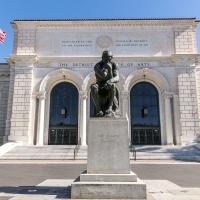 Detroit Institute of Arts
Detroit Institute of Arts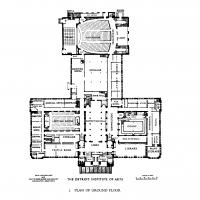 Plan of Ground Floor of Detroit Institute of Arts
Plan of Ground Floor of Detroit Institute of Arts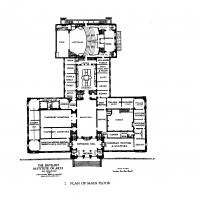 Plan of Main Floor of Detroit Institute of Arts
Plan of Main Floor of Detroit Institute of Arts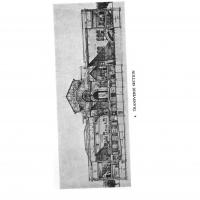 Transverse Section of Detroit Institute of Arts
Transverse Section of Detroit Institute of Arts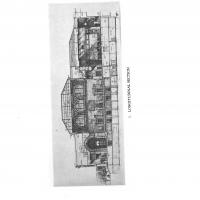 Longitudinal Section of Detroit Institute of Arts
Longitudinal Section of Detroit Institute of Arts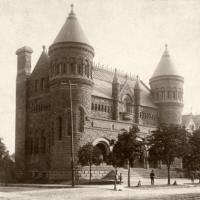 Detroit Museum of Art after it opened to the public in 1889
Detroit Museum of Art after it opened to the public in 1889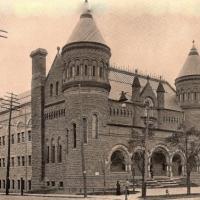 Detroit Museum of Art after expansion in 1906
Detroit Museum of Art after expansion in 1906





